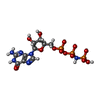+ Open data
Open data
- Basic information
Basic information
| Entry | Database: PDB / ID: 7kfz | ||||||
|---|---|---|---|---|---|---|---|
| Title | Structure of a ternary KRas(G13D)-SOS complex | ||||||
 Components Components |
| ||||||
 Keywords Keywords | HYDROLASE/SIGNALING PROTEIN / Ras / Sos / GTPase / HYDROLASE-SIGNALING PROTEIN complex | ||||||
| Function / homology |  Function and homology information Function and homology informationmidbrain morphogenesis / regulation of pro-B cell differentiation / vitellogenesis / pericardium morphogenesis / cardiac atrium morphogenesis / heart trabecula morphogenesis / regulation of T cell differentiation in thymus / GTPase complex / Interleukin-15 signaling / positive regulation of small GTPase mediated signal transduction ...midbrain morphogenesis / regulation of pro-B cell differentiation / vitellogenesis / pericardium morphogenesis / cardiac atrium morphogenesis / heart trabecula morphogenesis / regulation of T cell differentiation in thymus / GTPase complex / Interleukin-15 signaling / positive regulation of small GTPase mediated signal transduction / Activation of RAC1 / blood vessel morphogenesis / Signaling by LTK / epidermal growth factor receptor binding / response to mineralocorticoid / GMP binding / Regulation of KIT signaling / positive regulation of epidermal growth factor receptor signaling pathway / forebrain astrocyte development / leukocyte migration / LRR domain binding / NRAGE signals death through JNK / regulation of synaptic transmission, GABAergic / negative regulation of epithelial cell differentiation / response to isolation stress / response to gravity / epithelial tube branching involved in lung morphogenesis / neurotrophin TRK receptor signaling pathway / Fc-epsilon receptor signaling pathway / type I pneumocyte differentiation / eyelid development in camera-type eye / Rac protein signal transduction / GRB2:SOS provides linkage to MAPK signaling for Integrins / positive regulation of Rac protein signal transduction / roof of mouth development / regulation of T cell proliferation / B cell homeostasis / Signaling by RAS GAP mutants / Signaling by RAS GTPase mutants / Activation of RAS in B cells / myoblast proliferation / RET signaling / skeletal muscle cell differentiation / RAS signaling downstream of NF1 loss-of-function variants / RUNX3 regulates p14-ARF / positive regulation of glial cell proliferation / SOS-mediated signalling / Activated NTRK3 signals through RAS / Activated NTRK2 signals through RAS / fibroblast growth factor receptor signaling pathway / Role of LAT2/NTAL/LAB on calcium mobilization / SHC1 events in ERBB4 signaling / Interleukin receptor SHC signaling / hair follicle development / cardiac muscle cell proliferation / Signalling to RAS / Signal attenuation / Activated NTRK2 signals through FRS2 and FRS3 / SHC-related events triggered by IGF1R / Estrogen-stimulated signaling through PRKCZ / Schwann cell development / glial cell proliferation / SHC-mediated cascade:FGFR3 / MET activates RAS signaling / SHC-mediated cascade:FGFR2 / PTK6 Regulates RHO GTPases, RAS GTPase and MAP kinases / Signaling by PDGFRA transmembrane, juxtamembrane and kinase domain mutants / Signaling by PDGFRA extracellular domain mutants / SHC-mediated cascade:FGFR4 / Erythropoietin activates RAS / SHC-mediated cascade:FGFR1 / Signaling by FGFR4 in disease / Signaling by CSF3 (G-CSF) / FRS-mediated FGFR3 signaling / Signaling by FLT3 ITD and TKD mutants / FRS-mediated FGFR2 signaling / FRS-mediated FGFR4 signaling / p38MAPK events / FRS-mediated FGFR1 signaling / Signaling by FGFR3 in disease / protein-membrane adaptor activity / Tie2 Signaling / striated muscle cell differentiation / Signaling by FGFR2 in disease / RAC1 GTPase cycle / myelination / GRB2 events in EGFR signaling / SHC1 events in EGFR signaling / Signaling by FLT3 fusion proteins / FLT3 Signaling / Signaling by FGFR1 in disease / EGFR Transactivation by Gastrin / FCERI mediated Ca+2 mobilization / NCAM signaling for neurite out-growth / homeostasis of number of cells within a tissue / CD209 (DC-SIGN) signaling / GRB2 events in ERBB2 signaling / Downstream signal transduction / Insulin receptor signalling cascade / Ras activation upon Ca2+ influx through NMDA receptor Similarity search - Function | ||||||
| Biological species |  Homo sapiens (human) Homo sapiens (human) | ||||||
| Method | ELECTRON MICROSCOPY / single particle reconstruction / cryo EM / Resolution: 3.47 Å | ||||||
 Authors Authors | Liu, C. / Moghadamchargari, Z. / Laganowsky, A. / Zhao, M. | ||||||
| Funding support |  United States, 1items United States, 1items
| ||||||
 Citation Citation |  Journal: Proc Natl Acad Sci U S A / Year: 2021 Journal: Proc Natl Acad Sci U S A / Year: 2021Title: Molecular assemblies of the catalytic domain of SOS with KRas and oncogenic mutants. Authors: Zahra Moghadamchargari / Mehdi Shirzadeh / Chang Liu / Samantha Schrecke / Charles Packianathan / David H Russell / Minglei Zhao / Arthur Laganowsky /  Abstract: Ras is regulated by a specific guanine nucleotide exchange factor Son of Sevenless (SOS), which facilitates the exchange of inactive, GDP-bound Ras with GTP. The catalytic activity of SOS is also ...Ras is regulated by a specific guanine nucleotide exchange factor Son of Sevenless (SOS), which facilitates the exchange of inactive, GDP-bound Ras with GTP. The catalytic activity of SOS is also allosterically modulated by an active Ras (Ras-GTP). However, it remains poorly understood how oncogenic Ras mutants interact with SOS and modulate its activity. Here, native ion mobility-mass spectrometry is employed to monitor the assembly of the catalytic domain of SOS (SOS) with KRas and three cancer-associated mutants (G12C, G13D, and Q61H), leading to the discovery of different molecular assemblies and distinct conformers of SOS engaging KRas. We also find KRas exhibits high affinity for SOS and is a potent allosteric modulator of its activity. A structure of the KRas•SOS complex was determined using cryogenic electron microscopy providing insight into the enhanced affinity of the mutant protein. In addition, we find that KRas-GTP can allosterically increase the nucleotide exchange rate of KRas at the active site more than twofold compared to KRas-GTP. Furthermore, small-molecule Ras•SOS disruptors fail to dissociate KRas•SOS complexes, underscoring the need for more potent disruptors. Taken together, a better understanding of the interaction between oncogenic Ras mutants and SOS will provide avenues for improved therapeutic interventions. | ||||||
| History |
|
- Structure visualization
Structure visualization
| Movie |
 Movie viewer Movie viewer |
|---|---|
| Structure viewer | Molecule:  Molmil Molmil Jmol/JSmol Jmol/JSmol |
- Downloads & links
Downloads & links
- Download
Download
| PDBx/mmCIF format |  7kfz.cif.gz 7kfz.cif.gz | 159.3 KB | Display |  PDBx/mmCIF format PDBx/mmCIF format |
|---|---|---|---|---|
| PDB format |  pdb7kfz.ent.gz pdb7kfz.ent.gz | 121.4 KB | Display |  PDB format PDB format |
| PDBx/mmJSON format |  7kfz.json.gz 7kfz.json.gz | Tree view |  PDBx/mmJSON format PDBx/mmJSON format | |
| Others |  Other downloads Other downloads |
-Validation report
| Summary document |  7kfz_validation.pdf.gz 7kfz_validation.pdf.gz | 1.1 MB | Display |  wwPDB validaton report wwPDB validaton report |
|---|---|---|---|---|
| Full document |  7kfz_full_validation.pdf.gz 7kfz_full_validation.pdf.gz | 1.1 MB | Display | |
| Data in XML |  7kfz_validation.xml.gz 7kfz_validation.xml.gz | 33.8 KB | Display | |
| Data in CIF |  7kfz_validation.cif.gz 7kfz_validation.cif.gz | 52.4 KB | Display | |
| Arichive directory |  https://data.pdbj.org/pub/pdb/validation_reports/kf/7kfz https://data.pdbj.org/pub/pdb/validation_reports/kf/7kfz ftp://data.pdbj.org/pub/pdb/validation_reports/kf/7kfz ftp://data.pdbj.org/pub/pdb/validation_reports/kf/7kfz | HTTPS FTP |
-Related structure data
| Related structure data |  22857MC M: map data used to model this data C: citing same article ( |
|---|---|
| Similar structure data | |
| EM raw data |  EMPIAR-10894 (Title: Single-particle cryoEM data of a ternary KRas(G13D)-SOS complex EMPIAR-10894 (Title: Single-particle cryoEM data of a ternary KRas(G13D)-SOS complexData size: 3.7 TB Data #1: Unaligned raw movie of SOS-KRas (G13D) complex [micrographs - multiframe]) |
- Links
Links
- Assembly
Assembly
| Deposited unit | 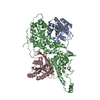
|
|---|---|
| 1 |
|
- Components
Components
| #1: Protein | Mass: 19386.848 Da / Num. of mol.: 2 / Mutation: G13D Source method: isolated from a genetically manipulated source Source: (gene. exp.)  Homo sapiens (human) / Gene: KRAS, KRAS2, RASK2 / Production host: Homo sapiens (human) / Gene: KRAS, KRAS2, RASK2 / Production host:  #2: Protein | | Mass: 57449.691 Da / Num. of mol.: 1 / Fragment: UNP residues 564-1049 Source method: isolated from a genetically manipulated source Source: (gene. exp.)  Homo sapiens (human) / Gene: SOS1 / Production host: Homo sapiens (human) / Gene: SOS1 / Production host:  #3: Chemical | ChemComp-GNP / | #4: Chemical | ChemComp-MG / | Has ligand of interest | N | |
|---|
-Experimental details
-Experiment
| Experiment | Method: ELECTRON MICROSCOPY |
|---|---|
| EM experiment | Aggregation state: PARTICLE / 3D reconstruction method: single particle reconstruction |
- Sample preparation
Sample preparation
| Component | Name: A ternary complex of KRas(G13D) and SOScat / Type: COMPLEX / Entity ID: #1-#2 / Source: RECOMBINANT |
|---|---|
| Molecular weight | Value: 0.0967 MDa / Experimental value: YES |
| Source (natural) | Organism:  Homo sapiens (human) Homo sapiens (human) |
| Source (recombinant) | Organism:  |
| Buffer solution | pH: 7.4 |
| Specimen | Conc.: 8.6 mg/ml / Embedding applied: NO / Shadowing applied: NO / Staining applied: NO / Vitrification applied: YES |
| Vitrification | Instrument: FEI VITROBOT MARK IV / Cryogen name: ETHANE / Humidity: 100 % / Chamber temperature: 281 K |
- Electron microscopy imaging
Electron microscopy imaging
| Experimental equipment |  Model: Titan Krios / Image courtesy: FEI Company |
|---|---|
| Microscopy | Model: FEI TITAN KRIOS |
| Electron gun | Electron source:  FIELD EMISSION GUN / Accelerating voltage: 300 kV / Illumination mode: FLOOD BEAM FIELD EMISSION GUN / Accelerating voltage: 300 kV / Illumination mode: FLOOD BEAM |
| Electron lens | Mode: BRIGHT FIELD / Nominal magnification: 105000 X / Nominal defocus max: 2500 nm / Nominal defocus min: 800 nm / Cs: 2.7 mm |
| Image recording | Electron dose: 65 e/Å2 / Film or detector model: GATAN K3 BIOQUANTUM (6k x 4k) / Num. of real images: 5202 |
- Processing
Processing
| Software | Name: PHENIX / Version: 1.18.2_3874: / Classification: refinement | ||||||||||||||||||||||||||||||||
|---|---|---|---|---|---|---|---|---|---|---|---|---|---|---|---|---|---|---|---|---|---|---|---|---|---|---|---|---|---|---|---|---|---|
| EM software |
| ||||||||||||||||||||||||||||||||
| CTF correction | Type: PHASE FLIPPING ONLY | ||||||||||||||||||||||||||||||||
| Particle selection | Num. of particles selected: 5749548 | ||||||||||||||||||||||||||||||||
| Symmetry | Point symmetry: C1 (asymmetric) | ||||||||||||||||||||||||||||||||
| 3D reconstruction | Resolution: 3.47 Å / Resolution method: FSC 0.143 CUT-OFF / Num. of particles: 1021288 / Symmetry type: POINT | ||||||||||||||||||||||||||||||||
| Atomic model building | B value: 50 / Protocol: AB INITIO MODEL / Space: REAL | ||||||||||||||||||||||||||||||||
| Atomic model building | PDB-ID: 1XD2 Accession code: 1XD2 / Source name: PDB / Type: experimental model | ||||||||||||||||||||||||||||||||
| Refine LS restraints |
|
 Movie
Movie Controller
Controller



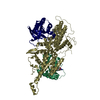
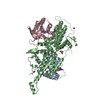
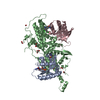
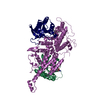
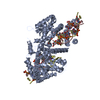
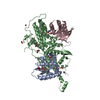
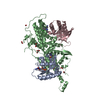
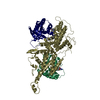
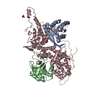
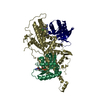
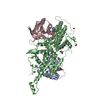
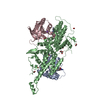
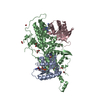
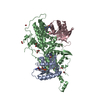
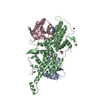
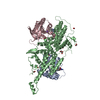
 PDBj
PDBj
























